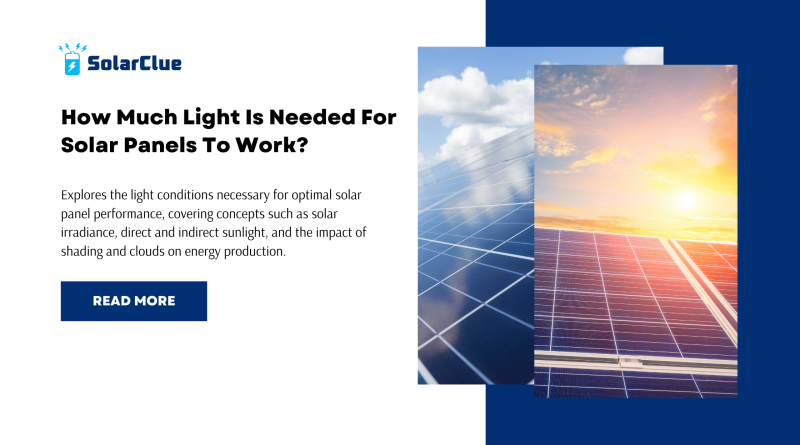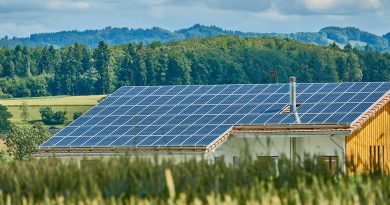How Much Light Is Needed For Solar Panels To Work?
For solar panels to perform optimally, they must receive adequate sunlight. The amount and type of light that reaches your solar panels directly affect their efficiency and energy output. This blog explores the light conditions necessary for optimal solar panel performance, covering concepts such as solar irradiance, direct and indirect sunlight, and the impact of shading and clouds on energy production.
Table of Contents
- 1 The Relationship Between Sunlight and Solar Panel Output
- 1.1 The Impact of Solar Irradiance on Energy Generation
- 1.2 The Difference Between Direct and Indirect Sunlight
- 1.3 The Effect of Shading on Solar Panel Performance
- 1.4 Optimizing Solar Panel Placement for Maximum Sunlight Exposure
- 1.5 Solar Panel Performance in Cloudy Weather Conditions
- 1.6 The Role of Solar Panel Technology in Low-Light Environments
- 1.7 The Importance of Considering Location and Climate for Solar Panel Installation
- 1.8 Conclusion
- 1.9 FAQs
The Relationship Between Sunlight and Solar Panel Output
Solar panels convert sunlight into electricity through photovoltaic cells. The amount of electricity generated depends on the intensity and duration of sunlight received.
| Sunlight Factor | Impact on Solar Panel Output |
|---|---|
| Intensity (Solar Irradiance) | Higher intensity increases energy production. |
| Duration (Sunlight Hours) | Longer sunlight hours lead to more electricity generated. |
| Sunlight Quality | Clear, direct sunlight produces more energy than diffused sunlight. |
The Impact of Solar Irradiance on Energy Generation
Solar irradiance is the measure of the power of sunlight hitting a given area, typically expressed in watts per square meter (W/m²). It directly affects the energy output of solar panels.
Example:
- Standard Test Conditions (STC): Panels are rated at 1,000 W/m².
- Actual Irradiance: If the actual irradiance is 800 W/m², the panel’s output will be proportionally lower.
| Irradiance Level (W/m²) | Expected Output (%) |
|---|---|
| 1,000 (STC) | 100% |
| 800 | 80% |
| 600 | 60% |
| 400 | 40% |
The Difference Between Direct and Indirect Sunlight
Direct sunlight strikes the solar panels without being scattered, while indirect sunlight is diffused through clouds, atmosphere, or other obstructions. Solar panels are most efficient under direct sunlight.
| Sunlight Type | Description | Impact on Efficiency |
|---|---|---|
| Direct Sunlight | Sunlight that reaches the panels directly. | Highest efficiency, maximum energy output. |
| Indirect Sunlight | Sunlight scattered by clouds or reflected off surfaces. | Lower efficiency, reduced energy output. |
The Effect of Shading on Solar Panel Performance
Shading significantly reduces the performance of solar panels by blocking sunlight. Even partial shading can cause a disproportionate drop in energy production due to the way solar panels are wired in series.
Example:
- Scenario: A tree partially shades one panel in a series.
- Impact: The output of the entire string of panels can be reduced, sometimes by as much as 50%.
| Shading Type | Impact on Solar Panel Performance |
|---|---|
| Full Shading | Drastically reduces or even stops energy production. |
| Partial Shading | Causes significant drops in output, especially in series connections. |
Optimizing Solar Panel Placement for Maximum Sunlight Exposure
Proper placement is crucial to maximize sunlight exposure. Panels should be oriented and tilted to capture the most sunlight throughout the day.
| Placement Factor | Recommendation |
|---|---|
| Orientation | South-facing in the northern hemisphere for maximum exposure. |
| Tilt Angle | Angle should match the latitude of the location. |
| Avoiding Shading | Install panels away from potential shading sources like trees or buildings. |
Solar Panel Performance in Cloudy Weather Conditions
Cloudy weather reduces solar irradiance, leading to lower energy production. However, solar panels can still produce electricity under cloudy conditions, although at a reduced rate.
| Weather Condition | Impact on Energy Production |
|---|---|
| Clear Sky | Maximum energy production. |
| Partly Cloudy | Moderate reduction in output (10-30%). |
| Overcast | Significant reduction in output (30-70%). |
The Role of Solar Panel Technology in Low-Light Environments
Different solar panel technologies perform differently in low-light conditions:
| Panel Technology | Performance in Low-Light Conditions |
|---|---|
| Monocrystalline | High efficiency, better performance in low light. |
| Polycrystalline | Moderate efficiency, decent performance in low light. |
| Thin-Film | Best in low-light environments, less affected by shading. |
The Importance of Considering Location and Climate for Solar Panel Installation
Location and climate play a critical role in determining the effectiveness of a solar panel installation. Consider the following factors:
| Location/Climate Factor | Impact on Solar Panel Performance |
|---|---|
| Latitude | Influences the optimal tilt angle for solar panels. |
| Seasonal Variations | Affects the amount of sunlight available throughout the year. |
| Local Weather Patterns | Frequent cloudy or rainy weather reduces overall energy production. |
Conclusion
Understanding the light conditions required for optimal solar panel performance is essential for maximizing energy output. By considering factors such as solar irradiance, direct and indirect sunlight, shading, and location-specific conditions, you can optimize your solar panel installation for the best results.
Here at SolarClue®, we offer a smart, practical, and “beautiful” solution. You will be answered for all the questions related to Solar.
We provide all kinds of brands that are the Best Solar panels in India.
If you are the one who is planning for the solar power system. Don’t hesitate to contact our team!
Looking forward to empowering you with solar energy, just like hundreds of our other clients!
FAQs
1. How does solar irradiance affect solar panel output?
Solar irradiance measures the power of sunlight per unit area. Higher irradiance leads to higher energy production.
2. What is the difference between direct and indirect sunlight?
Direct sunlight reaches the panels without obstruction, while indirect sunlight is scattered, leading to reduced efficiency.
3. How does shading impact solar panel performance?
Shading can significantly reduce energy output, especially in systems where panels are connected in series.
4. What role does panel orientation play in solar energy production?
Proper orientation ensures that panels receive maximum sunlight throughout the day, increasing energy output.
5. Can solar panels work efficiently in cloudy weather?
Yes, but their efficiency is reduced. The output depends on the density of the clouds and the type of solar panels used.



